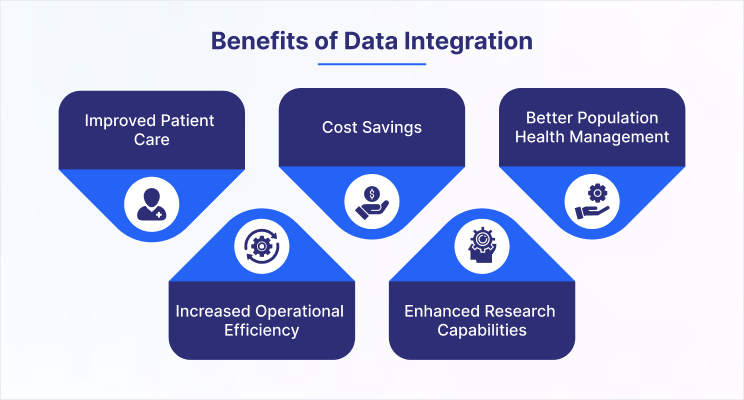|
Getting your Trinity Audio player ready... |
As healthcare continues to embrace the digital age, the importance of data integration cannot be overstated. Combining and analyzing data from various sources is critical for improving patient outcomes, increasing efficiency and productivity, and enhancing population health management. However, the challenges of data integration in healthcare are many and varied. This article will explore the definition of data integration in healthcare, its importance, challenges, and solutions.
Data integration services in healthcare refer to combining data from multiple sources, such as electronic health records (EHRs), medical devices, and health information exchanges (HIEs). This data can be used to gain insights into patient health, identify trends and patterns, and develop better treatment plans. Data integration is critical for delivering personalized, patient-centered care and improving health outcomes.
Challenges in Data Integration
1. Technical Challenges
One of the primary technical challenges of data integration is dealing with heterogeneous data formats and standards. Different systems and devices may use different data structures, making combining and analyzing the data effectively difficult. Limited interoperability among systems is another challenge, as many healthcare systems are not designed to work together seamlessly. It can result in silos of information that are difficult to integrate.
Security and privacy concerns are also major challenges in data integration. Healthcare data is highly sensitive and must be protected from unauthorized access or disclosure. Limited scalability and flexibility are also challenges, as healthcare organizations must scale their data integration efforts as their needs change.
2. Organizational Challenges
Organizational challenges in data integration include a lack of standardization, poor data governance, resistance to change, and limited financial resources. Without standardization, it can be challenging to ensure that data is collected, stored, and shared consistently and meaningfully. Poor data governance can lead to data quality issues, while resistance to change can hinder the adoption of new technologies and workflows. Limited financial resources can also be a significant barrier to effective data integration.
Solutions for Data Integration
Technical Solutions
Standardizing data formats and vocabularies is one technical solution for data integration. Using standardized formats makes it easier to combine and analyze data from multiple sources. Application Programming Interfaces (APIs) are another solution, as it allows different systems to communicate and share data in a standardized way. Data harmonization and mapping can also help to overcome the challenges of heterogeneous data formats and standards. Integrating Artificial Intelligence (AI) and Machine Learning (ML) can help automate the data integration process and identify patterns and trends that may not be immediately apparent.
Organizational Solutions
Developing effective data governance policies is a key organizational solution for data integration. It includes defining data ownership, ensuring data quality, and establishing data access and use protocols. Collaboration among stakeholders is also essential, as it helps ensure that all parties work towards a common goal. Investment in IT infrastructure is another important solution, as it provides the necessary resources and tools to support data integration efforts. Staff training and education are also critical, as it helps ensure that everyone in the organization understands the importance of data integration and how to use the tools and processes effectively.
Benefits of Data Integration

The benefits of data integration services in healthcare are numerous.
1. Improved Patient Care
Data integration allows healthcare providers to access all patient data from various sources in a single location. This makes it easier for doctors to make more informed decisions about patient care, leading to better outcomes and higher patient satisfaction.
2. Cost Savings
By integrating data from different sources, healthcare providers can reduce duplication of tests and procedures, avoid errors and unnecessary treatments, and optimize resource allocation. This ultimately results in significant cost savings for healthcare organizations.
3. Better Population Health Management:
Data integration services enable healthcare providers to identify trends and patterns across large populations, allowing them to manage chronic diseases proactively, identify potential outbreaks, and monitor public health risks.
4. Increased Operational Efficiency:
Integrating data across different healthcare systems and departments streamline administrative tasks, reduces paperwork, and improves overall operational efficiency. This can result in better resource utilization, lower staff turnover, and improved patient satisfaction.
5. Enhanced Research Capabilities
Data integration enables researchers to access a wider range of patient data and develop more comprehensive insights into health conditions and treatment outcomes. This can lead to improved clinical trials, better drug development, and more effective disease management strategies.
Also read: Why Is Tableau The Best Data Visualization Tool For Businesses?
Strategies for Overcoming Data Integration Challenges
- Develop a Data Integration Strategy
Developing a data integration strategy is essential for healthcare organizations. The strategy should identify the data sources, quality requirements, standardization requirements, and governance policies.
- Invest in Data Quality Management Processes
Investing in data quality management processes is critical for ensuring accuracy and completeness. Healthcare organizations should establish data quality metrics, perform regular quality checks, and invest in data cleansing tools.
- Use Standardized Data Formats, Definitions, and Codes
Standardizing data formats, definitions, and codes can help overcome the challenges of integrating data from different sources. Healthcare organizations should adopt industry standards such as HL7, FHIR, and SNOMED CT.
- Implement Interoperable Systems
Implementing interoperable systems is essential for data integration. Healthcare organizations should invest in systems that can exchange data seamlessly, such as EHR systems that support HL7 or FHIR.
Conclusion
Data integration services in healthcare are essential for healthcare organizations to provide quality care, improve patient outcomes, and reduce costs. However, integrating data from different sources can be challenging. Healthcare organizations must develop a data integration strategy, invest in data quality management processes, standardize data formats, definitions, and codes, and implement interoperable systems to overcome these challenges. By doing so, they can ensure that they have accurate, complete, and reliable data to support their operations and improve patient care.